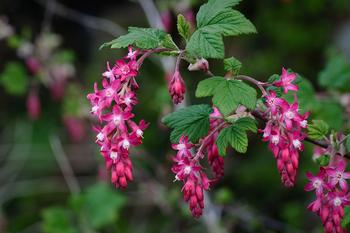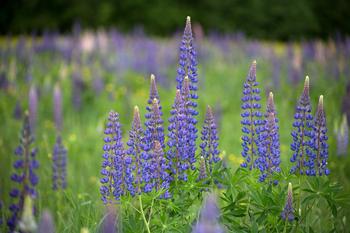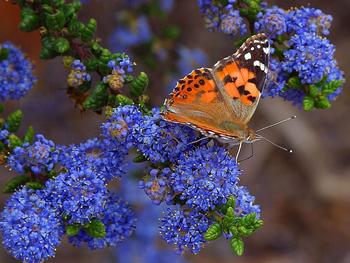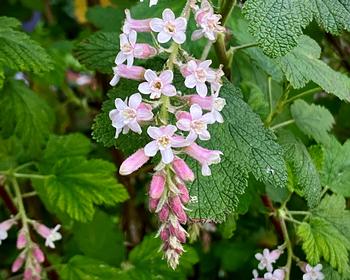The benefits of keystone species outweigh their numbers
-
Barbara Robertson
-
Many gardeners know the key role milkweed (Asclepias) plays in bringing back declining numbers of Monarch butterflies. But other species of Lepidoptera, other butterflies, and moths need help, too.
 4 ribes species, sanguineum (above), sanguineum var. glutinosum, malvaceum & californicum, support 39 butterfly & moth species. Photo: Mark Robinson
4 ribes species, sanguineum (above), sanguineum var. glutinosum, malvaceum & californicum, support 39 butterfly & moth species. Photo: Mark RobinsonButterflies and moths are more than just pretty pollinators; they and their caterpillars are critical components of the food web. Fortunately, gardeners can help slow Lepidoptera decline by growing keystone plants. While some plants like milkweed are singularly important for particular wildlife, keystone plants are essential for the survival of species diversity.
Credit for the concept of keystone plants goes to 19th-century naturalist Alexander von Humboldt, the first person to recognize the holistic web of connections in nature. Rockstar famous at the time but relatively unknown now, his ideas influenced Darwin, Thoreau, Muir, and many others. During one of Humboldt’s journeys early in the 1800s, as he crossed a Venezuelan savannah, he observed the ecosystem evolving around a palm tree. He recognized that tree as what we now call a keystone species. In 1969, zoologist Robert T. Paine coined the term.
In a Roman arch, the keystone at the top locks all the other stones into position and allows the arch to bear weight. If you remove a keystone, the arch collapses. In nature, if a keystone species becomes extinct, other species will likely disappear, too. Many Lupine species are wildflowers in Marin, but can thrive in gardens as evergreen perennials or annuals that reseed. Photo: Negative Space
Many Lupine species are wildflowers in Marin, but can thrive in gardens as evergreen perennials or annuals that reseed. Photo: Negative SpaceA study by University of Delaware researchers Desiree L. Narango, Douglas W. Tallamy & Kimberley J. Shropshire published in Nature Communications (November 2020) illustrates the point. The title tells the story: “Few keystone plant genera support the majority of Lepidoptera species.” They discovered that 14 percent of the local plant genera in the counties they studied supported more than 90 percent of Lepidoptera diversity. The plants in that 14 percent are the keystone species.
All Earth-Friendly Gardens need to support many species of pollinators and wildlife, not only butterflies and moths. But if these keystone species aren’t included, Lepidoptera’s “arch” becomes less stable.
The study notes: “…restoration actions that populate landscapes with native plants, but without members of keystone genera, are performing ineffectively and are unlikely to support similar diversity of local Lepidoptera species compared to landscapes that included keystone genera.” 5 varieties of ceanothus support 56 butterfly & moth species: Blueblossom, Buck Bush, Hairy, Point Reyes, and Wavy Leaved. Photo: Jon Sullivan Pixie
5 varieties of ceanothus support 56 butterfly & moth species: Blueblossom, Buck Bush, Hairy, Point Reyes, and Wavy Leaved. Photo: Jon Sullivan PixieSupporting this claim, their simulation found that 20 randomly chosen woody plants supported less than 40 percent of Lepidoptera species. But, when just half the twenty were keystone plants, the group supported more than 70 percent. Herbaceous plants have similar numbers: when half were keystone plants, the support increased from 13 to more than 40 percent.
Looked at another way, it would take 50 randomly chosen woody plants to reach 80 percent of the Lepidoptera species, but only 15 keystone woody plants. For herbaceous plants, even three times the plant richness could not capture the diversity of Lepidoptera species supported by a few keystone plants.
The study concludes: “Our results reveal that increasing plant diversity with the intentional inclusion of keystone plants is the most efficient and successful approach to support Lepidopteran diversity.”
The top five performing keystone plant genera in Marin County, according to an “advanced search” for “Marin County” native plants on the Calscape.org website, ordered by the number of butterflies hosted, are: Quercus (Oaks), Salix (Willow), Prunus (Cherries, Plums, etc.), Pinus (Pine), and Alnus (Alder). The search looked at Marin County as a whole; drilling down to individual addresses might produce slight differences. The winter-flowering Ribes malvaceum can thrive in part-shade. Photo: Barbara Robertson
The winter-flowering Ribes malvaceum can thrive in part-shade. Photo: Barbara RobertsonKeystone species other than trees are also important. Of those commonly available in nurseries and that support, at least 30 varieties of Butterflies and Moths are: Five varieties of Ceanothus (supporting 56 Lepidoptera species), four Ribes (39), and five Arctostaphylos aka Manzanita (32). A quick search will produce another handful of native plants that support at least 20 species of Lepidoptera. Many of these beautiful native plants would fit nicely into almost any garden and support wildlife species in addition to Lepidoptera, as well.
Even one plant could make a huge difference. For more information: https://marinmg.ucanr.edu.




